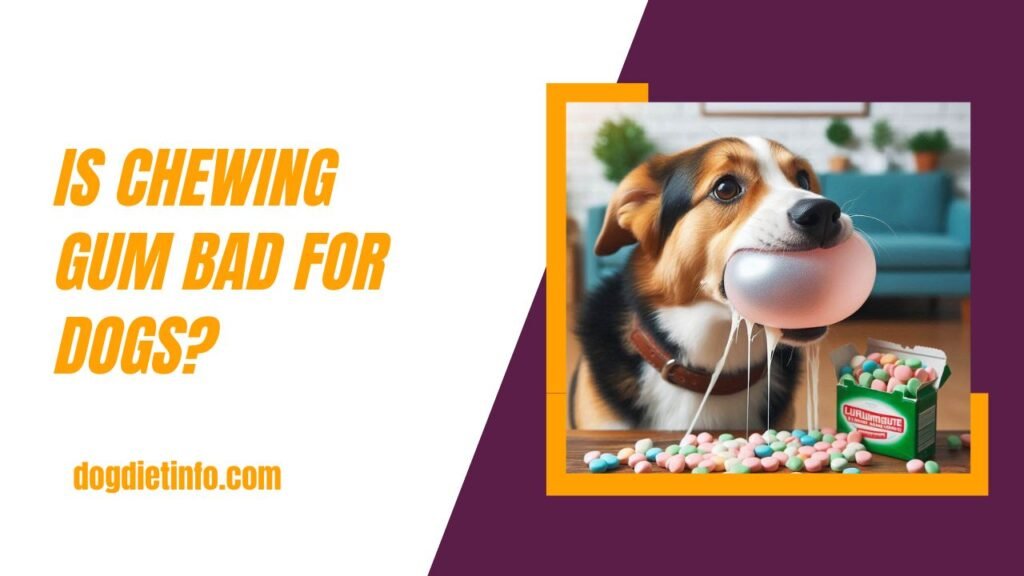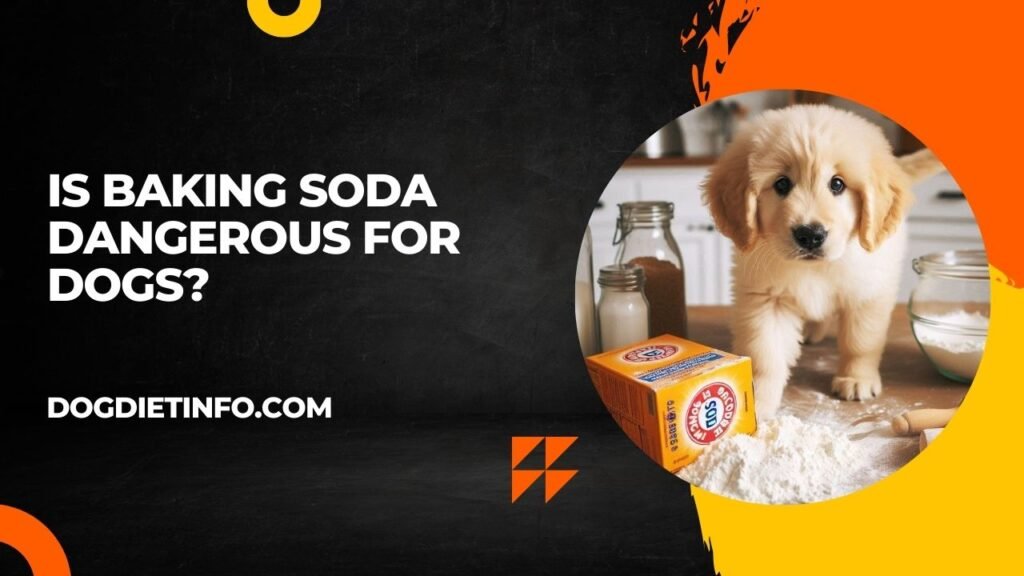Is Chewing Gum Bad For Dogs? Chewing gum can be harmful to dogs, especially if it contains xylitol, a sweetener that is toxic and can cause rapid insulin release.
We all know how much dogs love to chew things—whether it’s their favorite toy or something they’ve found around the house.
Unfortunately, dogs can sometimes get their paws (or teeth) on items that are harmful, and one common household item that poses significant danger is chewing gum.
While chewing gum is a harmless treat for humans, it can be extremely dangerous—even deadly—for dogs. [Is Chewing Gum Bad For Dogs?]
In this article, we will explore the dangers of chewing gum for dogs, what makes it so toxic, the symptoms of gum poisoning, and what you can do to prevent this kind of incident.
Contents
What Makes Chewing Gum Dangerous for Dogs?
Chewing gum contains various ingredients that may seem harmless to us but can be dangerous to dogs. [Is Chewing Gum Bad For Dogs?]
The real danger comes from specific chemicals and compounds that a dog’s system cannot process.
Let’s break down the top three dangers associated with chewing gum and why it should be kept far away from dogs.
Xylitol Toxicity
The most significant threat to dogs from chewing gum is a sweetener called xylitol, commonly found in sugar-free gums.
Xylitol is safe for human consumption, but for dogs, even small amounts can be fatal. When a dog ingests xylitol, their body mistakenly releases an excessive amount of insulin.
This insulin spike causes a rapid decrease in blood sugar levels, a condition called hypoglycemia, which can occur within 10 to 60 minutes of ingestion.
Hypoglycemia can cause a wide range of dangerous symptoms, from weakness and lethargy to seizures, and if left untreated, it can be fatal.
Even a single piece of gum containing xylitol can cause severe hypoglycemia in small dogs, and larger amounts can lead to liver failure or death.
Choking Hazard
In addition to the toxic risk of xylitol, chewing gum also poses a choking hazard for dogs, particularly for smaller breeds or puppies.
Dogs don’t chew the same way humans do, and they might try to swallow gum whole.
Gum can easily become lodged in their throat or airway, leading to asphyxiation. [Is Chewing Gum Bad For Dogs?]
Even if the gum does not cause immediate choking, it can block the digestive tract. Gum is not digestible and can accumulate in the stomach or intestines, forming a mass called a bezoar.
This blockage can cause severe gastrointestinal problems, including vomiting, constipation, and abdominal pain, often requiring surgery to remove.
Artificial Ingredients
Besides xylitol, many chewing gums contain artificial sweeteners, preservatives, and flavorings.
These chemicals may not be immediately toxic to dogs but can still cause significant problems. [Is Chewing Gum Bad For Dogs?]
Artificial ingredients like aspartame or sorbitol are often included in gum for taste, and while they don’t pose the same risk as xylitol, they can cause digestive distress in dogs, leading to vomiting, diarrhea, and stomach upset.
Dogs’ digestive systems are sensitive to certain chemicals that humans can tolerate, so even non-xylitol gums should be avoided.
See Also: Is Brewers Yeast Safe For Dogs?

Symptoms of Chewing Gum Poisoning in Dogs
If your dog has eaten chewing gum, the signs of poisoning can appear quickly, especially if the gum contains xylitol. Here are the key symptoms to watch for:
1. Vomiting
Vomiting is often one of the first signs of gum ingestion. It’s the body’s natural way of trying to expel a foreign substance, but in the case of xylitol poisoning, it can indicate a much more serious issue.
2. Lethargy and Weakness
A dog that is suddenly weak, lethargic, or showing signs of drowsiness may be experiencing a drop in blood sugar levels. This can happen rapidly after ingesting xylitol, and the dog’s energy levels will plummet.
3. Tremors and Seizures
If a dog’s blood sugar drops too low, they may experience tremors or even full seizures. This is a serious medical emergency and requires immediate veterinary attention. [Is Chewing Gum Bad For Dogs?]
4. Loss of Coordination (Ataxia)
Ataxia refers to a lack of coordination or the inability to control movement, often seen as stumbling or staggering. In dogs, this symptom can indicate neurological issues stemming from xylitol poisoning.
5. Rapid Heart Rate and Breathing
Xylitol poisoning can cause the dog’s heart to race and their breathing to become rapid or shallow. These are signs of severe distress and could indicate that the dog’s condition is deteriorating.
6. Coma
In extreme cases, especially if left untreated, xylitol poisoning can cause a dog to fall into a coma. If your dog is unconscious or unresponsive after ingesting gum, this is a life-threatening emergency.
What to Do If Your Dog Eats Chewing Gum
If you suspect your dog has eaten chewing gum, time is of the essence. Here’s what you should do:
1. Check for Xylitol
The first step is to check the packaging of the gum. Look for the word “xylitol” in the ingredients list.
If you don’t have the packaging, assume the gum may contain xylitol and act accordingly. Xylitol is most commonly found in sugar-free gums, but always check to be sure.
2. Remove the Gum
If your dog is still chewing the gum, try to remove it from their mouth as quickly and safely as possible. Be cautious, as dogs may panic or try to swallow the gum.
3. Call Your Veterinarian
Call your vet immediately for advice. Let them know the approximate amount of gum your dog has eaten and whether the gum contains xylitol.
In many cases, the vet may recommend bringing your dog in for an emergency evaluation. [Is Chewing Gum Bad For Dogs?]
4. Pet Poison Helpline
If you’re unsure what to do and your vet is not immediately available, call the Pet Poison Helpline at (855) 764-7661 for assistance.
They can offer specific advice on how to handle gum poisoning based on the type and amount of gum ingested.
5. Inducing Vomiting
Do not attempt to induce vomiting unless specifically instructed to do so by your vet. [Is Chewing Gum Bad For Dogs?]
In some cases, inducing vomiting can make the situation worse, especially if your dog is already showing symptoms of poisoning.
6. Emergency Treatment
If xylitol poisoning is suspected, your vet will likely take immediate action to stabilize your dog.
This may include administering intravenous (IV) fluids, monitoring blood sugar levels, and giving medications to prevent liver damage.
In severe cases, your dog may need to stay in the hospital for several days. [Is Chewing Gum Bad For Dogs?]
Prevention Tips
While it’s impossible to keep an eye on your dog 24/7, there are steps you can take to minimize the risk of chewing gum poisoning. Here are some practical tips to keep your dog safe:
Keep Gum Out of Reach
Store all gum, especially sugar-free varieties, in a sealed container or in a high cupboard where your dog can’t access it. Dogs are notorious for getting into things, so it’s best to err on the side of caution.
Educate Family Members and Visitors
Make sure that everyone in your household is aware of the dangers of chewing gum to dogs.
It’s also important to remind guests or babysitters to be mindful of where they leave their bags or personal items, as gum can easily fall out and be picked up by a curious dog.
Be Mindful of Purses and Backpacks
Dogs are curious creatures and may rummage through bags left on the floor or on a low table. [Is Chewing Gum Bad For Dogs?]
Keep purses, backpacks, and gym bags containing gum out of reach, as dogs can sniff out the scent and may chew through the bag to get to the gum.
Safe Chewing Alternatives
Provide your dog with plenty of safe chewing alternatives like dog toys or dog-friendly treats. This can help curb their desire to chew on things they shouldn’t.
Final Verdict
In summary, chewing gum is highly dangerous for dogs, particularly when it contains xylitol, a substance that is toxic to dogs. [Is Chewing Gum Bad For Dogs?]
Even gum without xylitol can pose risks of choking and gastrointestinal blockages. The best course of action is to keep gum far out of reach and remain vigilant about what your dog has access to.
If your dog does manage to ingest chewing gum, it’s crucial to seek veterinary help immediately to prevent life-threatening consequences.
Always stay alert to protect your furry friend from the dangers of gum ingestion.
FAQs: Is Chewing Gum Bad For Dogs?
1. Can dogs eat any kind of gum safely?
No, dogs should not eat any kind of gum. Both sugar-free and regular gum can pose serious health risks, including xylitol poisoning and intestinal blockages.
2. How much xylitol is dangerous for dogs?
As little as 0.1 grams of xylitol per kilogram of body weight can cause hypoglycemia, and larger amounts can lead to liver failure. Even a single piece of sugar-free gum can be toxic to small dogs.
3. What should I do if I don’t know whether the gum contains xylitol?
If you are unsure whether the gum your dog ingested contains xylitol, assume that it does and contact your vet immediately. It’s better to be safe than sorry.
4. Is sugar-free gum more dangerous than regular gum for dogs?
Yes, sugar-free gum is more dangerous because it often contains xylitol, which is toxic to dogs. Regular gum can still be harmful due to its choking hazard and indigestible nature.
5. What other household items contain xylitol?
Xylitol is commonly found in sugar-free candies, mints, toothpaste, mouthwash, and some peanut butter brands. Always check the ingredients of products before

Derrick Wilcox is a certified canine behaviorist with over 12 years of experience at Happy Paws Animal Clinic and Pawsitive Training Center, helping pet owners ensure safer, healthier, and happier lives for their dogs.



